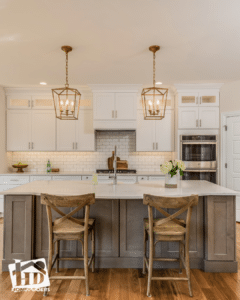More people are working from home than ever before, and even installing saunas and cold plunges in their homes. A functional and comfortable home office is an essential part of daily life. Whether you’re running a business, attending virtual meetings, or simply need a quiet place to focus, having a dedicated workspace can significantly boost productivity and work-life balance.
A well-designed home office minimizes distractions, improves efficiency, and creates a professional environment, even within the comfort of your home. But not everyone has the luxury of a separate office—especially in smaller homes. Fortunately, with the right design choices, you can carve out a productive workspace in almost any area.
By optimizing your home office setup, you’ll not only work more effectively but also create a space that feels inviting and inspiring. In this guide, we’ll explore how to create a home office, even in small spaces, so you can design a workspace that works for you.
Minimizing Distractions: Choosing the Right Location
The most important aspect of designing a productive home office is reducing distractions. A quiet workspace allows you to focus, maintain efficiency, and separate work from home life. Finding the right spot in your house—whether it’s a private room or a small designated corner—can make all the difference.
Where to Set Up Your Home Office
- Private Spaces: If available, basements, garages, or spare bedrooms provide the best privacy. These spaces allow you to work with minimal interruptions and establish a dedicated workspace.
- Alternative Small-Space Solutions: If you don’t have an extra room, you can still create an effective home office in a quiet part of your living space. Consider using:
- A designated corner of the living room.
- A hallway nook with a floating desk.
- A large closet transformed into a functional “cloffice.”
- A fold-out desk that can be stowed away when not in use.
- Acoustic Considerations: Household noise can be distracting, especially in shared living spaces. Soundproofing panels, thick rugs, and curtains can help absorb sound and create a quieter workspace.
Actionable Tips for Minimizing Distractions
- Choose a location with low foot traffic to avoid frequent interruptions.
- Use noise-canceling solutions such as carpets, curtains, and soft furniture to minimize background noise.
- Establish clear work boundaries by communicating with family members or housemates about your work schedule.
By choosing the right location, you set yourself up for success in creating a workspace that enhances focus and productivity.
Sharing an Office: Making It Work for Two People
For households with more than one remote worker, sharing an office space can be challenging. However, with the right setup, you can create a workspace that accommodates two people without sacrificing comfort or efficiency.
Best Strategies for Shared Offices
- Use Desk Dividers: Separating workstations with dividers, bookshelves, or curtains creates a sense of individual space and privacy.
- Position Desks Strategically: Placing desks facing away from each other reduces distractions and helps maintain focus.
- Manage Noise Effectively: Noise-canceling headphones or a white noise machine can help drown out household sounds and improve concentration.
- Schedule Work Hours: If possible, coordinate work schedules to allow for quiet periods when deep focus is needed.
Actionable Tips for a Functional Shared Office
- Define separate work zones using furniture placement or room dividers.
- Use shared storage solutions such as floating shelves or rolling carts to keep workstations clutter-free.
- Set expectations for noise levels and shared resources to ensure a productive and harmonious workspace.
A well-planned shared office can be just as functional as separate workspaces, making it easier for two people to work efficiently in the same room.
The Importance of Natural Light in Your Home Office
Lighting plays a crucial role in productivity and well-being. Natural light has been proven to boost energy levels, reduce eye strain, and enhance overall mood—essential benefits for a home office environment.
Why Natural Light Matters
- Improves Alertness: Exposure to natural light helps regulate sleep patterns, keeping you more awake and focused during the day.
- Reduces Eye Strain: Working under dim or artificial lighting for long hours can cause headaches and fatigue. Natural light minimizes these issues.
- Enhances Well-Being: Sunlight has been linked to better mental health and increased job satisfaction.
Read more about the benefits of natural light in office spaces here.
Solutions for Low-Light Workspaces
- Use LED Daylight Bulbs: These bulbs mimic natural light and create a bright, inviting workspace.
- Incorporate Mirrors: Positioning mirrors opposite windows helps reflect and amplify natural light throughout the room.
- Choose a Workspace Near a Window: If possible, set up your desk where you can benefit from direct sunlight.
Actionable Tips for Optimizing Light
- Keep blinds and curtains open during the day to let in as much natural light as possible.
- Use light-colored furniture and walls to enhance brightness and prevent a dark, enclosed feeling.
- Position your desk to face the window without direct glare on your screen.
A workspace with natural light fosters a comfortable, energizing environment that supports long-term productivity.
Comfortable Seating: The Key to Long-Term Productivity
Spending hours at your desk requires a chair that supports your posture and keeps you comfortable. The right office chair prevents back pain, improves focus, and enhances overall productivity.
Choosing the Right Office Chair
- Ergonomic Design: Look for a chair with adjustable lumbar support to maintain proper spinal alignment.
- Adjustable Features: Armrests, seat height, and reclining options allow for a customized sitting experience.
- Breathable Materials: Mesh-backed chairs promote airflow and prevent overheating during long work sessions.
Standing Desks and Sit-Stand Workstations
- Health Benefits: Standing desks help reduce the risks of prolonged sitting, such as back pain and poor circulation.
- Improved Focus: Alternating between sitting and standing throughout the day can boost energy levels and concentration.
- Space Efficiency: Many standing desks are adjustable, allowing you to switch between sitting and standing positions as needed.
Actionable Tips for a Comfortable Work Setup
- Test different chairs before purchasing to find the most comfortable option for your needs. You can start by reading these office chair reviews.
- Consider a standing desk converter if you don’t want to invest in a full sit-stand desk.
- Ensure your desk height matches your chair’s ergonomics to prevent strain on your wrists and shoulders.
A comfortable chair and an ergonomic workspace keep you productive while minimizing physical discomfort.
How Honey-Doers Can Help You Build the Perfect Home Office
At Honey-Doers Remodeling, we understand that creating a home office isn’t just about setting up a desk—it’s about designing a workspace that enhances productivity, comfort, and efficiency. Whether you need a full office remodel or creative solutions for a small home office, we provide expert guidance and customized designs to fit your needs.
How We Can Help:
- Custom Home Office Designs: We create workspaces that maximize function and fit seamlessly into your home.
- Space-Saving Solutions: From built-in desks to multi-functional furniture, we help homeowners make the most of their available space.
- Lighting and Comfort Optimization: Our team ensures your workspace has the right balance of natural light, ergonomic furniture, and practical design.
Ready to create your ideal home office? Contact Honey-Doers Remodeling today to transform your home into the perfect work-from-home environment!






